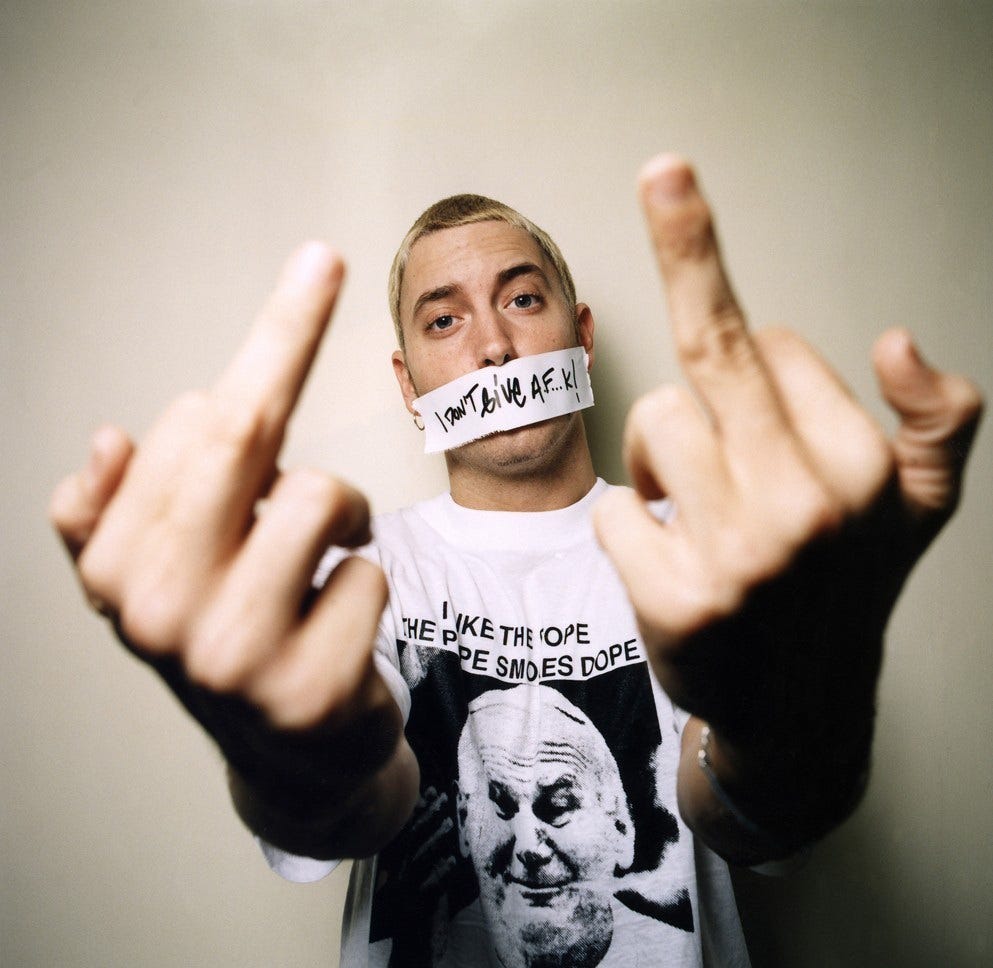Hip-Hop’s Battle Roots and the Aftermath of Eminem’s ‘Kamikaze’ Attack.
In 1973, DJ Kool Herc invented Hip-Hop. At the time, it was nothing more than a party in the Bronx but it would evolve into a thriving culture. It wouldn’t be until years later that the movement would be coined as ‘Hip-Hop’ and officially begin it’s infant crawl into school yards, parks, project buildings, and eventually radio waves.
Hip-Hop was a tool promoted and used as a way to combat the violence that ran rampant in many black communities. It was an outlet, a survival pack. It was a means to allow people to settle differences on wax. It was from this nature that Hip-Hop evolved from a party to competition and in 1982 battle rap was born when Kool Moe Dee got on the mic and dissed Busy Bee Starski in front of a live crowd.
Prior to this moment, an MC’s rhymes were relatively light-hearted, simple, and fun. Kool Moe Dee on the other hand made his rhymes heavy and complex. He delivered an antithesis to the game that would be the last needed component to separate the genre from other forms of music. It would inspire MC’s to take a more serious approach to not just their raps but also in creating songs.
An influx of battles between rivaling MC’s went toe-to-toe on the radio waves — Roxanne Shanté and The Real Roxanne, Boogie Down Productions versus the Juice Crew, Kool Moe Dee throwing shots at LL Cool J, and the battles continue through the 90’s and early 2000’s.
LL Cool J (Left) and Kool Moe Dee (Right)
The sub-culture of battle rapping is what makes Hip-Hop unique and a true outlier. It allows an entirely new lane for artists to explore and can do wonders for their career, just ask 50 Cent. Regardless of record sales or popularity, the true testament of an MC’s worth is measured by nothing more than the mic and the rhymes he or she spits on it. But being an incredible battle rapper doesn’t always warrant worldwide success. In fact, it’s a common flaw of many great battle rappers that despite the quality of their rhymes they often lack the finesse to craft a hit song.
The list of MC’s who were both legitimately great battle rappers and hit makers is incredibly small. Jay Z was known to engage in a battle rap or two back in his heyday but not only did he never dominate that realm like he does the mainstream, he was famously obliterated by the late-great Big L in a friendly battle of freestyles.
Enter Marshall Mathers. When it comes to Hip-Hop there is a reason why he is, at the very least, placed as one of the greatest of all time — if not, the greatest. Eminem is nearly unmatched in the every important facet of being a Hip-Hop artist.
Before Mr. Mathers catapulted into super stardom, he was making his rounds in Detroit competing in rap battles. His biggest moment of hope would come at the 1997 Rap Olympics where he would place 2nd overall. It was at this competition that his Slim Shady EP would find its way from his hands to Dr. Dre’s ears and well the rest is history.
That is until Eminem unleashed his tenth studio album Kamikaze this past Friday. A relentless work that pulled no punches and spared no target that Slim Shady felt deserving of an attack in retaliation to the critical and fan response to Revival. Marshall went battle mode and brought it back to the essence and the rawness that separates Hip-Hop from any other genre.
Hip-Hop thrives on confrontation and its ability to produce intense reactions from the media landscape. From “The Message” to “Fuck Tha Police”, rap has always been about ruffling feathers with public perception and opinion. Eminem is the pinnacle example of this archetype, particularly when he released The Marshall Mathers LP in 2000. The album was an exemplar of Hip-Hop excellence: impeccable flows, brutal battle raps, iconic song writing, and ruthless rhyme schemes. On top of all that, it was his ability to confront conflicts with censorship and freedom of speech.
In spite of the controversy and attempts to blockade The Marshall Mathers LP, it still sold a million records in its first week and 21-million to date. It garnered universal praise from his Hip-Hop aficionados and fans alike, and has gone down as one of the greatest Hip-Hop albums of all time. But regardless of these achievements the album didn’t receive such glowing reception from music critics. Though the overall reaction was positive there were a number of less than impressed reviews that were docking the album for its controversial content.

Fast-forward 18-years later, and Eminem’s 10th studio has highlighted a strong disconnect that still exists with critics and Hip-Hop. The culture has become so mainstream that critics have a dangerously skewed judgement of the culture.
In the realm of Hip-Hop an album like Kamikaze should be able to co-exist with the likes of Migos’ Culture. Both albums should be able to receive equal praise and criticisms for its highs and lows. Critics and fans should be well-versed enough that they can understand each their purpose and validity. Culture and Kamikaze are polar opposites but both are tied together by Hip-Hop’s roots — entertainment and sport.
Culture is a reformatting of Three 6 Mafia’s whole style that’s unique enough to feel fresh but safe enough to be accessible. It’s a rinse, wash, and repeat album that focuses on what works. Catchy hook, catchy beat, catchy flows, easy to follow content. And there’s nothing wrong with that if it’s done well.
Kamikaze embodies the sport end of the culture. Competitive and confrontational. A workshop of the genre’s potential when it comes to flows, rhyme schemes, and content. Anything and everything is fair game, friend or foe, all bets are off. Culture is pre-season, Kamikaze is the playoffs.
But reading the critical reception, it seems as though the battle rap aspect of Hip-Hop is slowly becoming lost. As with many genres that go mainstream, critics and the general public are more akin to attribute the likes of “Hotline Bling” closer to the culture’s DNA than “No Vaseline”. Though no irony is lost that Drake could arguably be considered one of the best battle rappers out right now.
Despite this, there is a silver-lining. Kamikaze went #1 in 70 countries immediately after its release, garnered enthusiastic praise from a large majority of fans, and ultimately sold 434,000 records in its first week — more than 150,000 than the universally panned and pop heavy Revival. Marshall would also become the first artist in history to have eight number one albums in a row on the Billboard Charts.
In war, there’s wins and losses on both sides. For Hip-Hop, it’s been at constant war with itself and the mainstream, trying to find balance between its ever-growing pop appeal while also maintaining the heart and soul of its origin. Regardless of one’s opinion on the Real Slim Shady, one thing nobody can deny is Eminem’s impact on both the mainstream and the culture — feels like May 23, 2000 all over again.












